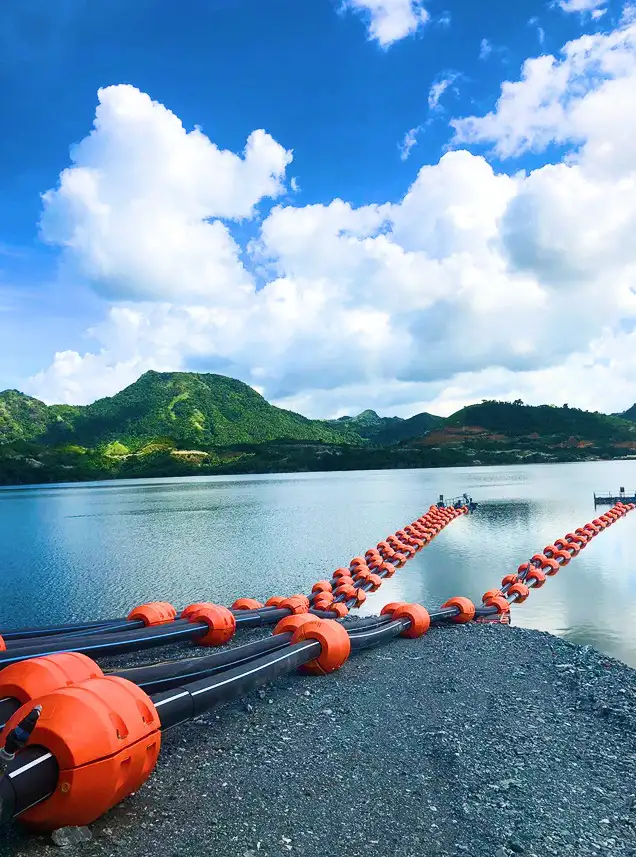
An HDPE (High-Density Polyethylene) floating hose is a specialized, engineered pipeline system designed to transport liquids, slurries, and granular materials across bodies of water. Its defining feature is its inherent buoyancy, allowing it to float on the surface without the need for external pontoons or supports.
An HDPE (High-Density Polyethylene) floating hose is a specialized type of pipeline designed to remain buoyant on the surface of water, making it ideal for various marine and dredging applications. Unlike traditional pipelines that sink, HDPE floating hoses are engineered with integrated floatation mechanisms, typically consisting of an outer shell made of durable HDPE material filled with high-strength, closed-cell polyurethane foam.
HDPE Shell: The outer layer is made from HDPE, known for its excellent flexibility, impact resistance, and durability. This material also offers high resistance to UV rays, saltwater, and chemicals.
Buoyancy Modules/Foam Core: The core of the hose or the attached floaters are filled with a closed-cell polyurethane foam. This foam is crucial for providing buoyancy and preventing water absorption, ensuring the hose stays afloat even in rough sea conditions.
Inner Liner: The innermost layer is resistant to the fluid being transported (e.g., mud, sand, oil, chemicals).
Reinforcement/Carcass: Layers of high tenacity fabrics or rubber provide reinforcement and help the hose maintain its shape, particularly for dredging applications where abrasive slurries are transported.
End Fittings: Equipped with flanges or other coupling mechanisms to connect to dredgers, offshore platforms, or other pipelines.
Buoyancy and Stability: The primary advantage is its ability to float, preventing it from sinking, getting entangled with underwater obstacles, or being damaged by contact with the seabed. This ensures continuous and efficient material transfer.
Durability and Resistance: HDPE material is highly resistant to abrasion, impact, corrosion, chemicals, and UV radiation, leading to a longer service life compared to traditional materials like steel. It can withstand harsh environmental conditions, including rough seas and temperature fluctuations.
Flexibility: HDPE hoses are flexible, allowing them to adapt to varying water currents, wave movements, and ground shifts without breaking. This reduces the need for numerous rigid connections and simplifies installation.
Lightweight and Easy Installation: Being significantly lighter than metal pipes, HDPE floating hoses are easier to transport, handle, and install, reducing labor costs and time.
Cost-Efficiency: Their long lifespan, minimal maintenance requirements, and ease of installation contribute to lower operational costs and a better return on investment.
Environmental Sustainability: HDPE is a recyclable material, making these hoses a more environmentally friendly choice. Their leak-free connections also help prevent environmental contamination.
High Flow Characteristics: The smooth inner surface of HDPE minimizes friction, ensuring efficient flow rates of transported materials.
HDPE floating hoses are crucial in various industries, especially those involving fluid or slurry transfer over water bodies:
Dredging Operations: Widely used to transport sediment, sand, mud, and gravel from dredgers to disposal sites or processing plants. They provide a flexible and reliable connection between the dredge head and the discharge point.
Offshore Oil and Gas: Used for transferring crude oil, natural gas, drilling mud, and other fluids between offshore rigs, production platforms, storage facilities, and tankers (ship-to-ship or ship-to-shore transfers).
Mining Applications: Facilitate the transport of minerals, ores, and tailings from offshore or riverside mines.
Environmental Management: Employed in projects like wetland restoration, pollutant control, and dewatering operations.
Port and Harbor Maintenance: Essential for maintaining navigable depths by transporting dredged materials.
Aquaculture: Used to support fish cages and nets in open water.
HDPE floating hoses are a robust, efficient, and increasingly preferred solution for buoyant fluid transfer in demanding marine and industrial environments due to their combination of durability, flexibility, and cost-effectiveness.
